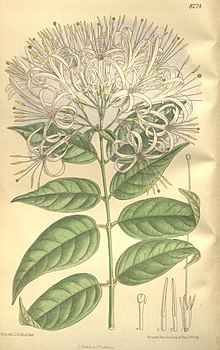Exostema
Exostema is a genus of flowering plants in the family Rubiaceae. It consists of trees and shrubs, endemic to the neotropics, with most of the species occurring in the West Indies.[1][2]
| Exostema | |
|---|---|
 | |
| Illustration of Exostemma subcordatum | |
| Scientific classification | |
| Kingdom: | Plantae |
| Clade: | Tracheophytes |
| Clade: | Angiosperms |
| Clade: | Eudicots |
| Clade: | Asterids |
| Order: | Gentianales |
| Family: | Rubiaceae |
| Subfamily: | Cinchonoideae |
| Tribe: | Chiococceae |
| Genus: | Exostema (Pers.) Rich. ex Humb. & Bonpl. |
| Type species | |
| Exostema caribaeum | |
| Synonyms | |
| |
Description
Exostema is a genus of neotropical trees and shrubs. The flowers have a slender corolla tube with recurved corolla lobes. The stamens are inserted near the base of the corolla tube and exserted well beyond its mouth. The anthers are long and basifixed.[3]
Systematics
The type species for the genus is Exostema caribaeum.[4] It is a tree of Central America and the Caribbean. Its lumber is of limited use.[1]
Exostema was first named by Christiaan Hendrik Persoon as a subgenus of Cinchona.[5] It was first validly published as a genus by Aimé Bonpland in 1807.[6][7] The generic name is derived from the Ancient Greek words, exo, meaning "outside", and stema, "stamen".[8]
Exostema is probably polyphyletic.[9]
Species
- Exostema acuminatum Urb.
- Exostema angustifolium (Sw.) Schult.
- Exostema bicolor Poepp.
- Exostema brachycarpum (Sw.) Schult.
- Exostema caribaeum (Jacq.) Schult.
- Exostema cordatum Borhidi & M.Fernandez
- Exostema coriaceum (Poir.) Schult.
- Exostema corymbosum (Ruiz & Pav.) Spreng.
- Exostema curbeloi Borhidi & M.Fernandez
- Exostema ellipticum Griseb.
- Exostema glaberrimum Borhidi & M.Fernandez
- Exostema lancifolium Borhidi & Acuna
- Exostema lineatum (Vahl) Schult.
- Exostema longiflorum (Lamb.) Schult.
- Exostema maynense Poepp.
- Exostema mexicanum A.Gray
- Exostema microcarpum Borhidi & M.Fernandez
- Exostema myrtifolium Griseb.
- Exostema nites Urb.
- Exostema orbiculatum Proctor
- Exostema parviflorum A.Rich. ex Humb. & Bonpl.
- Exostema pervestitum Borhidi & M.Fernandez
- Exostema polyphyllum Urb. & Ekman
- Exostema pulverulentum Borhidi
- Exostema purpureum Griseb.
- Exostema rotundatum Griseb.
- Exostema salicifolium Griseb.
- Exostema sanctae-luciae (Kentisch) Britten
- Exostema selleanum Urb.
- Exostema spinosum (Le Vavass.) Krug & Urb.
- Exostema stenophyllum Britton
- Exostema triflorum (W.Wright) G.Don
- Exostema valenzuelae A.Rich.
- Exostema velutinum Standl.
References
- Mabberley DJ (2008). Mabberley's Plant Book (3 ed.). Cambridge University Press. ISBN 978-0-521-82071-4.
- "Exostema in the World Checklist of Rubiaceae". Retrieved 20 June 2014.
- McDowell T; Bremer B (1998). "Phylogeny, diversity, and distribution in Exostema (Rubiaceae): implications of morphological and molecular analyses". Plant Systematics and Evolution. 212 (3–4): 215–246. doi:10.1007/bf01089740.
- "Exostema in the Index Nominum Genericorum". Retrieved 20 June 2014.
- Christiaan Hendrik Persoon. 1805. Synopsis plantarum,seu Enchiridium botanicum, complectens enumerationem systematicam specierum hucusque cognitarum /curante. 1:196.
- "Exostema in the International Plant Names Index". Retrieved 20 June 2014.
- Alexander von Humboldt and Aimé Bonpland. 1807. Plantes équinoxiales recueillies au Mexique :dans l'île de Cuba, dans les provinces de Caracas, de Cumana et de Barcelone, aux Andes de la Nouvelle Grenade, de Quito et du Pérou, et sur les bords du rio-Negro de Orénoque et de la rivière des Amazones. 1:131. F. Schoell: Paris, France.
- Quattrocchi U (2000). CRC World Dictionary of Plant Names. 1. Boca Raton, New York, Washington DC, London: CRC Press. ISBN 978-0-8493-2675-2.
- Manns U, Bremer B (2010). "Towards a better understanding of intertribal relationships and stable tribal delimitations within Cinchonoideae s.s. (Rubiaceae)". Molecular Phylogenetics and Evolution. 56 (1): 21–39. doi:10.1016/j.ympev.2010.04.002. PMID 20382247.